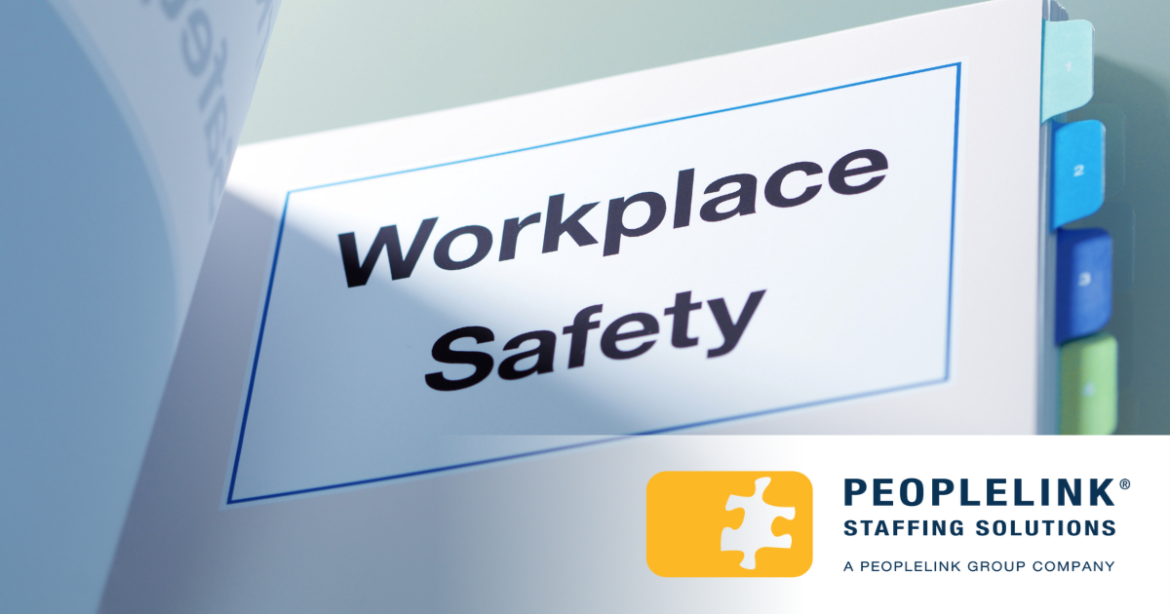
June is National Safety Month and it’s the perfect time to spotlight the systems, habits, and people that keep workplaces running safely and smoothly.
For many, the word “safety” brings to mind steel-toed boots, ear protection, or warning signs near heavy machinery. And while those are crucial in many of the light industrial roles we staff, safety encompasses more than personal protective equipment.
It’s also about lifting properly to prevent back strain, using ergonomic office setups to reduce repetitive stress, keeping walkways clear to avoid trips and falls, practicing cybersecurity to protect sensitive information, and having clear emergency protocols for everything from fire drills to data breaches.
Whether you’re operating a forklift, prepping inventory, working on the line, answering phones, or managing files, workplace safety matters. It just shows up in different ways. We’ve seen that safety concerns exist across all types of work environments. The key is recognizing them, addressing them, and building a culture where speaking up is encouraged.
2025 Safety Spotlights
The National Safety Council has announced four key focus areas for 2025:
- Continuous Improvement – Safety isn’t static. Organizations are encouraged to evaluate, adjust, and improve safety practices over time.
- Employee Engagement – Safe environments start with engaged employees who feel empowered to speak up and contribute.
- Roadway Safety – For those who drive as part of their job, staying alert, avoiding distracted driving, and following transportation best practices is critical.
- Wellbeing – From mental health to stress management, a holistic view of safety includes emotional and psychological health, too.
These spotlights offer a great foundation. Now let’s explore how safety takes shape in some of the specific industries we serve.
Safety in Light Industrial, Logistics, and Distribution Roles
In environments like logistics hubs, distribution centers, and light manufacturing facilities, safety is deeply physical. Workers face risks tied to motion, machinery, and materials, often while operating on tight timelines. For employers, the challenge is creating a culture that values safe choices even when the pressure is on.
Take food manufacturing as one example. Alongside the usual physical hazards—slippery floors, conveyor systems, heavy lifting—there are also strict hygiene and compliance rules. Gloves, masks, and hairnets aren’t optional, they’re safety tools. And cross-contamination doesn’t just affect the product; it can lead to costly recalls and health risks.
In a distribution warehouse, safety might mean:
- Staying aware of forklift traffic in shared lanes
- Following protocols for stacking and securing shipments
- Keeping walkways and loading areas clear to prevent trips or falls
- Using proper form and pacing to avoid strain, especially during peak hours
Other risks can be less visible but just as serious: fatigue from long shifts, repetitive stress injuries, or miscommunication during shift changes. These hazards increase when workers are new to the job or the facility layout.
That’s why onboarding is critical. Employers should make sure that every placement includes role-specific orientation, and we encourage our clients to reinforce safety expectations early and often. New or temporary workers may not yet know the flow of the floor, but they can be set up for success with:
- Clear signage and floor markings
- Accessible supervisors or peer mentors
- A culture that treats questions as a strength, not a setback
Workers should be encouraged to:
- Ask questions if instructions are unclear or equipment seems unfamiliar
- Report near misses, not just injuries, as these are warnings and point to what could go wrong
- Prioritize long-term safety over short-term speed, even in fast-paced environments
Safety in Administrative and Support Roles
Safety risks look different in office or similar support settings, but they still matter. Poor ergonomics, unclear digital protocols, or even workplace stress can all impact well-being and performance.
In administrative roles, safety may mean:
- Having a chair, keyboard, and monitor setup that reduces strain over long shifts
- Understanding how to protect sensitive data in systems-heavy roles
- Feeling safe to speak up when instructions are unclear, or deadlines feel unrealistic
Psychological safety is just as important as physical safety. When a staff member feels comfortable asking questions or pointing out a concern, they’re far more likely to work efficiently and avoid preventable mistakes.
Safety Month Is a Reminder, Not a One-Time Campaign
We believe safety is something you practice daily, not something you check off once a year.
For our clients, that means creating environments where all workers feel empowered to prioritize safety. For our candidates, it means staying alert, asking questions, and never feeling like you have to “just figure it out”. That’s the kind of culture we want to foster across every placement.
A Shared Responsibility Across Every Role
From the front office to the freezer dock, safety takes all of us. Employers, recruiters, supervisors, and workers all play a part. And while the risks may differ from one job to another, the responsibility doesn’t.
This Safety Month, take a look around: at your role, your workspace, your habits, and ask: What can I do today to help create a safer workplace for everyone around me?
If you’re a company looking for staffing support with a safety-first mindset or a candidate who wants to work in an environment that values your well-being, we’re here to help. Let’s talk.

